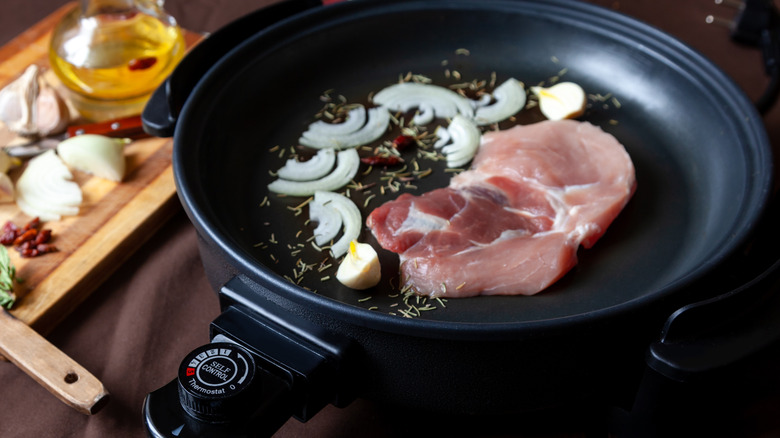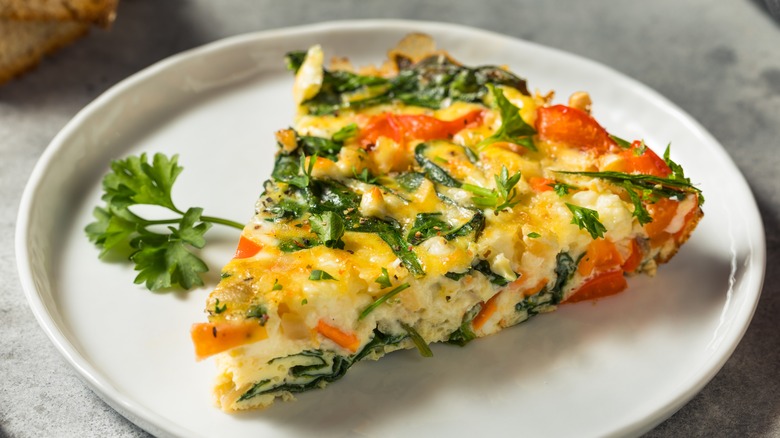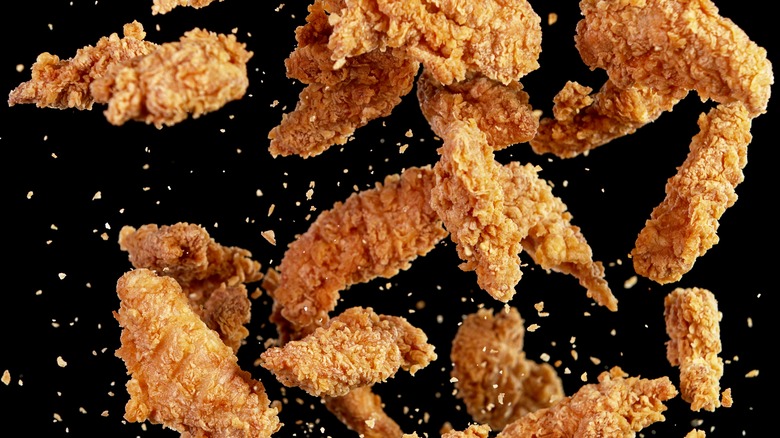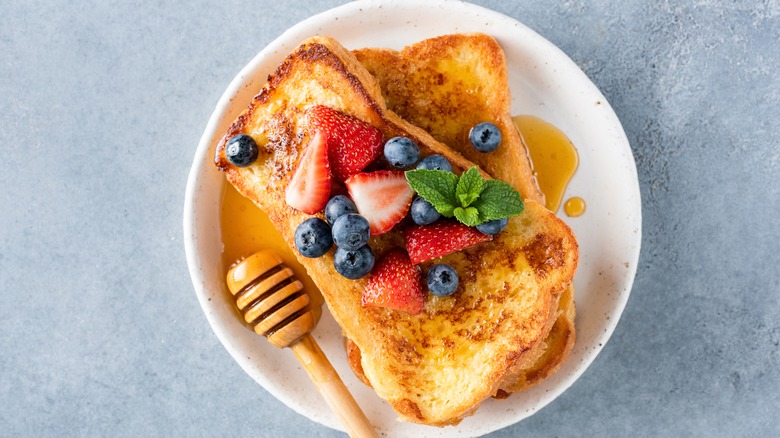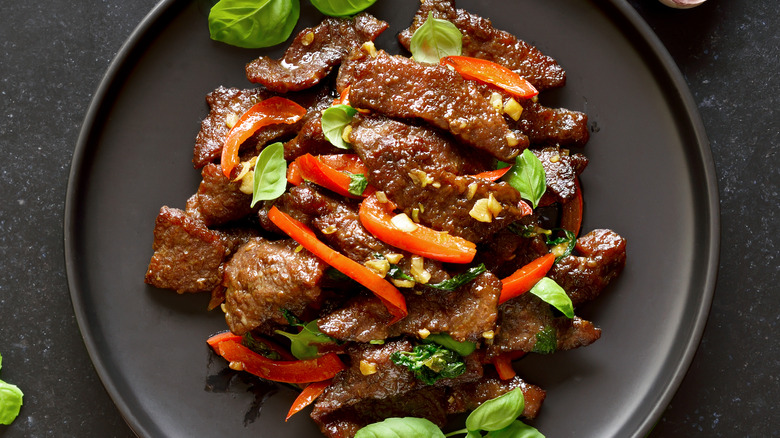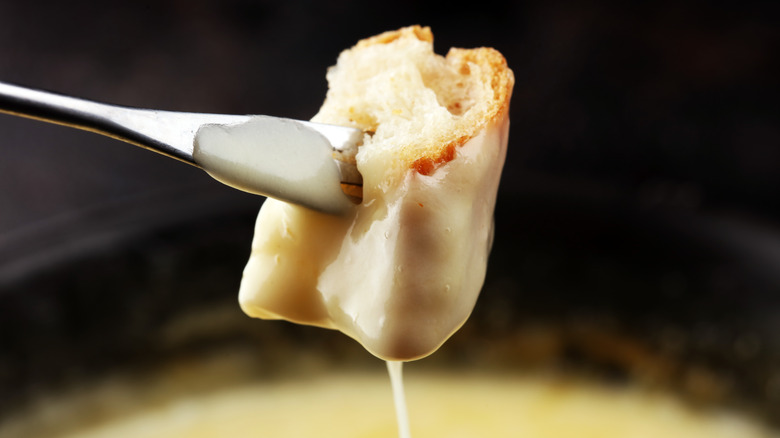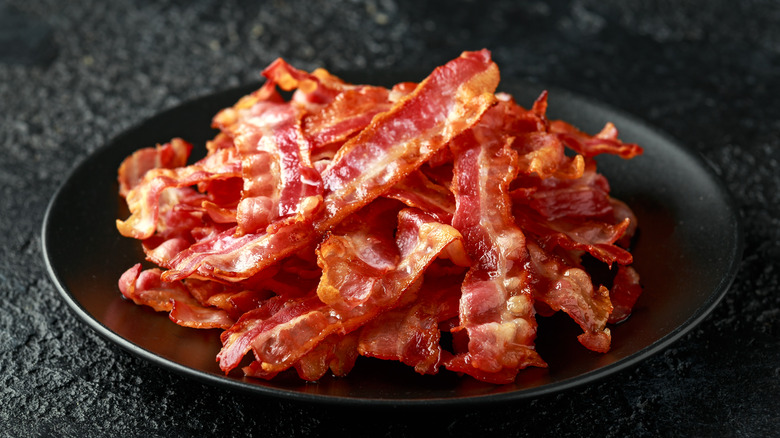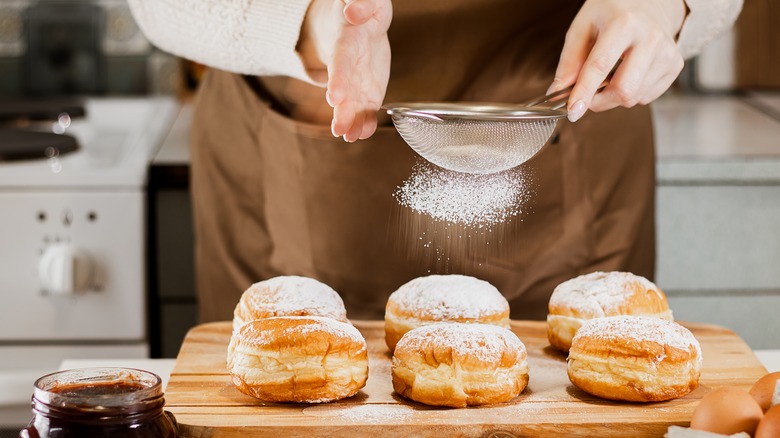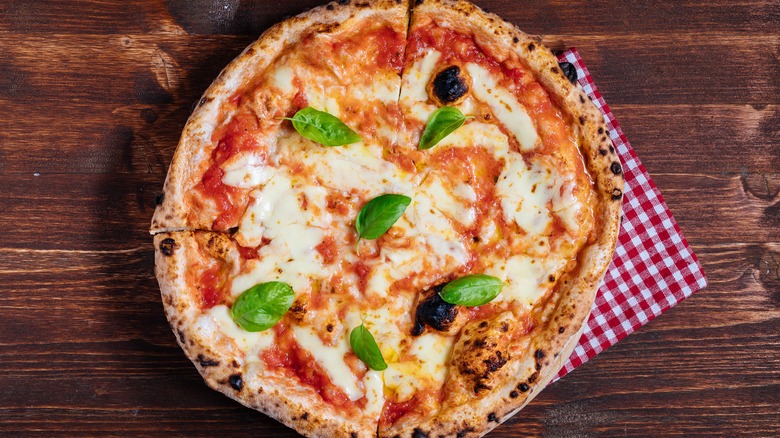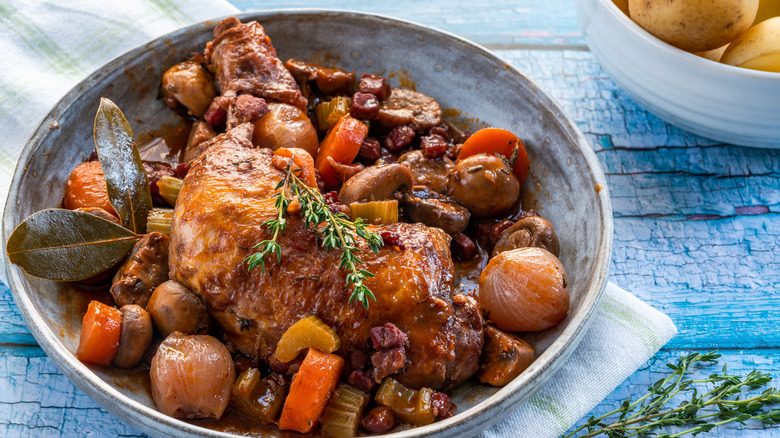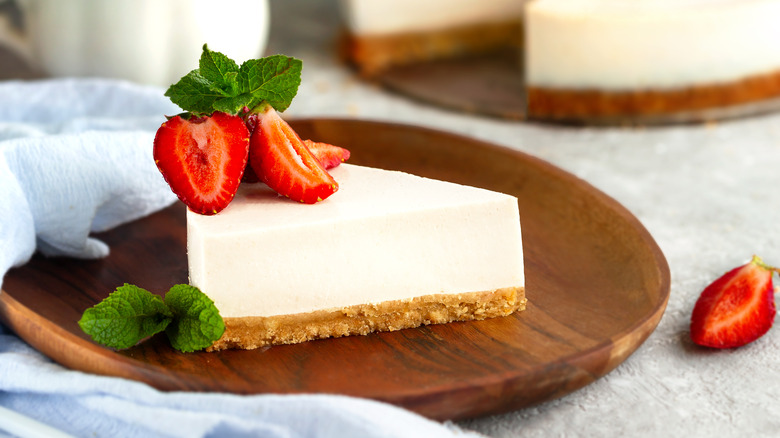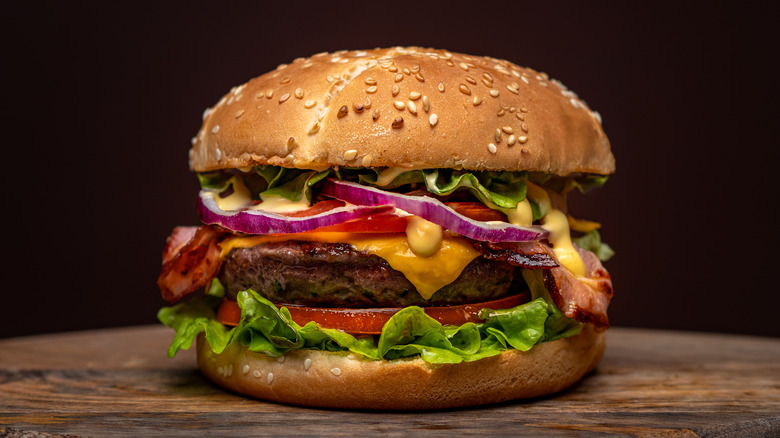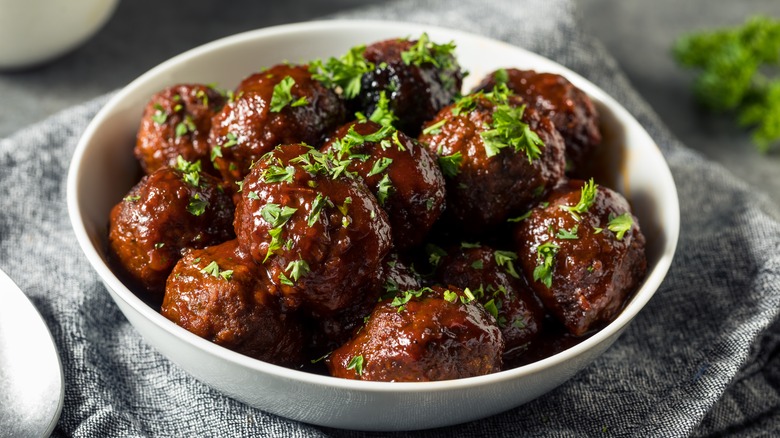The 12 Absolute Best Uses For Your Electric Frying Pan
The electric frying pan may not have the cult following of the Instant Pot, but it's a versatile cooking tool that more than earns its spot in any kitchen. Unlike a regular frying pan, it offers an extra heating element on busy holidays when the stovetop is full (we're looking at you, Thanksgiving) and it doesn't heat up the kitchen as much as a traditional stovetop pan, making it perfect for warm weather use too.
Electric frying pans come in a range of depths and sizes, allowing them to fry, braise, cook, and even bake a wide variety of foods. Their easy-clean nonstick surfaces, ability to choose the exact temperature of the pan, and cook-anywhere freedom make them a kitchen all-star. Most models can be fully submersed for cleaning or can even be popped into your dishwasher after removing the heat control.
There are some classic uses for an electric skillet you'll want to ensure you're not missing out on and some novel ways of baking some of your favorite foods in a new way. (Electric frying pan cheesecake anyone?) Our list below will remind you of some of these everyday recipes you may have forgotten and hopefully inspire you to experiment more with this often under-utilized kitchen tool.
Crack some eggs and make frittatas
Eggs are rich in nutrients and high in protein: a single egg contains a whopping 6 grams of protein, per WebMD. Frittatas let you stretch a couple of humble eggs into a substantial, filling meal and an electric frying pan is the perfect vessel for preparing them. Rather than cooking frittata ingredients in a pan on the stovetop, adding the eggs, and then moving to the oven to finish baking, an electric skillet allows you to make the entire meal in one place. Even better, there's no risk of burning your hands on a hot handle when moving the frittata back to the counter after finishing it in the oven (we've all forgotten the handle was hot at least once).
Simply sauté your vegetables or meat in a preheated electric frying pan, add the eggs, and close the lid, cooking until the eggs are set. While an oven-baked frittata can be broiled for a browned top, if you're looking for browning on both sides of an electric skillet frittata, you can flip it as soon as the bottom is firm enough (via DeLallo). Using the lid on your electric frying pan will help maintain moisture, keeping your frittata from drying out.
Frittatas are a great way to use up any remaining ingredients left over at the end of the week. Toss in a few handfuls of starting-to-wilt spinach, that rogue leftover piece of ham, and the feta that didn't quite make it into a salad, and you have a healthy and delicious meal that's ready in minutes.
Fry a batch of chicken
Plugging in a deep skillet to fry pickle juice-brined chicken may not be what Mary Randolph envisioned when her recipe for fried chicken was printed in 1824 (via BBC) but the wide appeal of crispy, golden brown fried chicken hasn't changed.
Anyone who has cooked fried chicken knows the enemy of a perfectly browned, crispy exterior is pre-heating oil to the wrong temperature. Too high and you've got burned crust and raw meat; too low and you have a pale, oily mess no one wants to eat. The best oil temperature for making fried chicken is 300 to 325 F and an electric frying pan allows you to choose the exact temperature you're aiming for, unlike guesstimating with the settings on your stovetop. Critically, it also maintains an even temperature.
According to Insider, most electric skillets can heat oil to reach 350 F in a swift five to seven minutes. Keeping the temperature from rising too high is especially important in frying because it prevents oil from reaching its smoking point, which creates a bitter off flavor. Vegetable oil is particularly great for frying because of its higher smoke point (400 F) and its neutral flavor.
Start your morning with French toast
French toast is a simple breakfast classic. Its limited ingredients make each choice crucial, whether it's picking the best type of bread for French toast, deciding on an optimal soak time, or choosing a cooking method. Turning to the electric skillet is no secret when it comes to making perfect French toast. Even Alton Brown prepares French toast in an electric frying pan (set at 375 F for anyone taking notes). The nonstick surface of an electric skillet means cleanup is a breeze and the steady, even heat allows the sugars in French toast to caramelize properly. Don't be tempted to use the lid in this application of your electric skillet — moisture will build up, ruining the crisped brown surface.
If you're preparing breakfast for a crowd, be sure to follow Alton Brown's trick for keeping French toast warm and crisp. He recommends putting finished slices in a 375 F oven as you go to keep them warm. Have leftovers? You can even freeze extra French toast and enjoy those Sunday-morning vibes on a busy weekday morning.
Make delectable stir-fries
Electric frying pans with deeper, more sloped sides are a great way to make one-pot meals like stir-fries, albeit in a less-than-authentic way. While they won't ever match the wok hei (the unique and delicious flavors created by cooking in a roaring hot wok), the electric skillet allows you to enjoy a classic stir-fry quickly and easily without ever turning on your stovetop.
Traditional woks use very high heat, which you'll want to mimic by preheating to your electric skillet's highest heat setting and using an oil with a high smoking point. Like woks, electric frying pans have a nonstick surface that helps you keep food moving during its quick cook time. The added bonus is your electric skillet can be used for a variety of other dishes long after you're done with your stir-fry.
There's no limit to how many different kinds of stir-fries you could make by choosing different cuts of meat, keeping it vegetarian, and whipping up a fast, homemade stir-fry sauce.
Get cheesy with fondue
One delicious and cheesy use for an electric skillet is making and keeping fondue warm. Whether you're whipping up enough for a party or simply want to eat melted cheese on the couch for dinner while you watch your favorite cooking show on Netflix, an electric skillet will make quick work of gently melting your seasoned cheese and getting a delicious dinner on the table.
Modern fondue has its origins in the 1800s, per BBC. While it is traditionally made over an open flame, and more recently a stovetop or electric fondue pot, an electric frying pan is a natural stand-in for making any basic cheese fondue recipe. The steady, even nature of the heating means you can dial down to the lowest setting, or use the "keep warm" function if your model has it, to keep things melted, gooey, and ready to eat.
Hate doing extra dishes? You can even use the electric skillet to cook your dip-ins first by frying up slices of sausage, vegetables, or browning cubes of bread in butter (or bacon fat) and using the flavorful liquid left behind as the base for your fondue, with one less dish to clean.
We'd be remiss if we left out one final suggestion: chocolate fondue is another amazing use for an electric skillet. The method above works just as well — try browning cubes of pound cake in butter instead for dip-ins.
Crisp up some bacon
Long before "bringing home the bacon" meant bringing in money, bacon was the staple meat of peasants in Western Europe, according to Brittanica. While cardiologists don't recommend it as a staple food, it's an easy and delicious way to amp up any meal from bacon at breakfast all the way to bacon for dessert.
There are almost as many ways to cook bacon as there are ways to eat it and the electric frying pan is a classic method. It cooks bacon evenly and can be set to a lower temperature to slowly render fat without burning the meat.
Electric frying pans are especially great for making one-pot meals. For any recipe containing bacon, we recommend cooking the strips first, setting them aside, and using the leftover fat as the base for a pan sauce for cooking vegetables or preparing any other recipe that allows you to capitalize on the liquid gold bacon leaves behind.
If you don't like crispy bacon, the electric skillet is definitely the way to go. The raised edges of the pan allow you to cook your pork belly strips in water, which is the trick to keeping bacon from crisping as it cooks while evenly browning the meat.
Time to make the donuts
Deeper electric frying pans offer an optimal way to create one of your favorite treats at home: the humble donut. If you're a donut fan and you haven't made them at home before, you're in for a treat.
If you're wondering how hot your oil needs to be when frying donuts, the optimal temperature is 350 F. Make sure to avoid common mistakes like overloading your frying pan and not allowing the donuts to drain properly. Unlike a traditional frying pan, you won't need to break out the candy thermometer to track the temperature of the oil. Simply set your electric skillet to your chosen temperature and ensure you allow enough time between batches for the oil temperature to rebound from the drop caused by a cold batter.
The beauty of making your own donuts at home is honing in on making your Platonic ideal donut, be it apple cider donuts, strawberry jelly-filled, the classic glazed, something innovative like a cinnamon roll donut recipe (yes, please), or even savory donuts. Gluten-free pumpkin doughnuts? You can make those too.
Pizza doesn't require an oven
Baking is an overlooked cooking method the electric skillet excels at. The lid of an electric skillet helps trap heat within the pan while the heated bottom and sides brown. This is where making pizza enters the chat.
An electric frying pan pizza offers the best of both worlds: a soft, melty top, and a browned, crispy bottom. The insulated interior of the pan gently melts cheese and cooks toppings, while the bottom of your pizza browns evenly. Because the electric skillet doesn't have a heating element at the top of the unit, toppings should be cut small and used conservatively to ensure they heat through properly. Any toppings that shed liquid when cooked like onion, cherry tomatoes, or bell peppers should be cooked beforehand to avoid a soggy pizza.
If you don't have the time or the energy to make pizza from scratch and want to pull out a frozen pizza, you'll still want to plug in your electric skillet for the best results. It works beautifully to reheat leftover pizza as well.
Prepare mouthwatering braises
The electric skillet is perfectly suited to cook braises. The first step is to sear your meat and brown your vegetables. They can stick around in the pan to be evenly cooked in a flavorful liquid, thanks to the skillet's higher curved sides.
The deep, caramelized flavors and supple textures of braising mean this method of cooking is delicious for everything from chicken thighs to pot roast to pork — and don't forget about vegetarian mainstays like white beans.
The key to braising tough cuts is letting the meat cook slowly; cooking at a temperature that's too high is one of several common braising mistakes home cooks often make. A lower temperature allows connective tissues to break down into gelatin, keeping meat moist and providing a velvety texture. This is why the best cuts of meat for braising are ones that have lots of connective tissue that would be tough for the grill — think more chuck roast, less filet mignon.
Even cheesecake makes the cut
Next time you're planning on baking a cheesecake, consider using an electric frying pan. Unlike an oven, the electric skillet only directly heats from the bottom, giving the cheesecake a browned, crisp bottom. Using the lid traps hot air and steam to set the center and top as it gently cooks from the top and sides without cracking.
The concept is similar to making cheesecake in a slow cooker. An electric skillet with enough depth lets you create a shallow water bath for gentle baking and small balls of foil can be used under the bottom of the pan so it isn't in direct contact with the heating surface of the skillet. Voila: a creamy, crack-free cheesecake. How can you tell if it's done? Just give it a jiggle.
Now that you've mastered the basics, change it up to try a tiramisu cheesecake, baked ricotta cheesecake, or eggnog cheesecake. As with all cheesecake, remember to chill overnight and use room-temperature ingredients.
Flip out over burgers
The average American eats three hamburgers a week according to PBS. If you're planning on making them at home, you may want to skip the stove opt and opt for an electric frying pan. The biggest benefit is that you'll be able to hone in on the perfect level of doneness because the skillet heats evenly and allows you to choose an exact temperature. Keep in mind that the USDA recommends cooking burgers to an internal temperature of 160 F.
From choosing the right ground beef to deciding what epic toppings to include, a great burger is all about personalization. With a little planning ahead, many popular toppings like caramelized onions or bacon can even be cooked in your electric skillet before the patties.
Plug in your electric frying pan and get ready for the ultimate burgers without worrying about firing up the grill on a hot, rainy, or even snowy day. Vegetarians and vegans: an electric skillet is also a great way to cook a plant-based burger.
Don't forget the meatballs
Meatballs are a versatile food that can be made as a delicious and easy one-pot meal using an electric frying pan. As with other meals, due to the nonstick interior of electric skillets, cleanup is easy.
Whatever version you choose, be it Italian, Swedish, Moroccan, barbecue, or vegetarian, you'll want to avoid common meatball mistakes like over-mixing your meat. For those with egg allergies, we recommend substituting with Michael Symon's secret meatball ingredient: ricotta.
Once the meatballs (or lentil balls) have taken on color in your preheated electric frying pan, set them aside and build your sauce right in the electric skillet. The meatballs can finish cooking directly in the simmering sauce, absorbing flavors and cooking through to the perfect temperature without falling apart. The lid helps prevent the meatballs from drying out and the lowest setting or "keep warm" function on your skillet will ensure a piping hot dinner without risking overcooking your meatballs.
